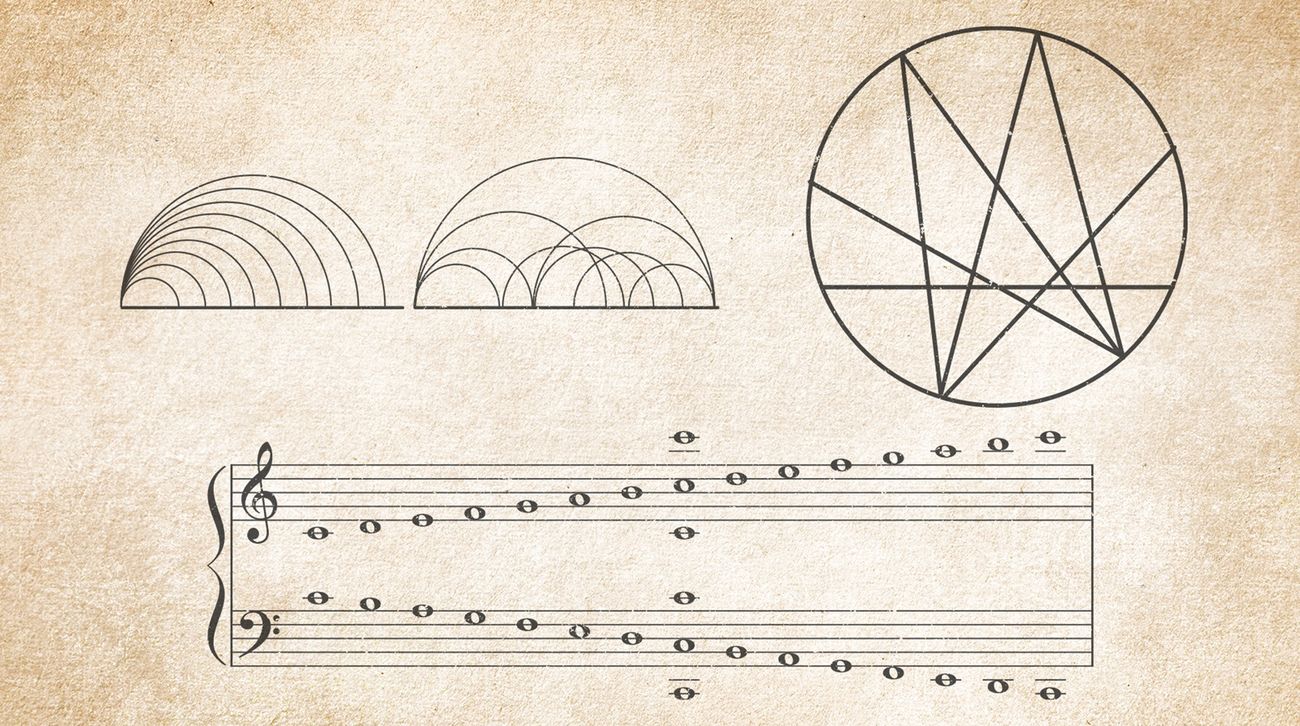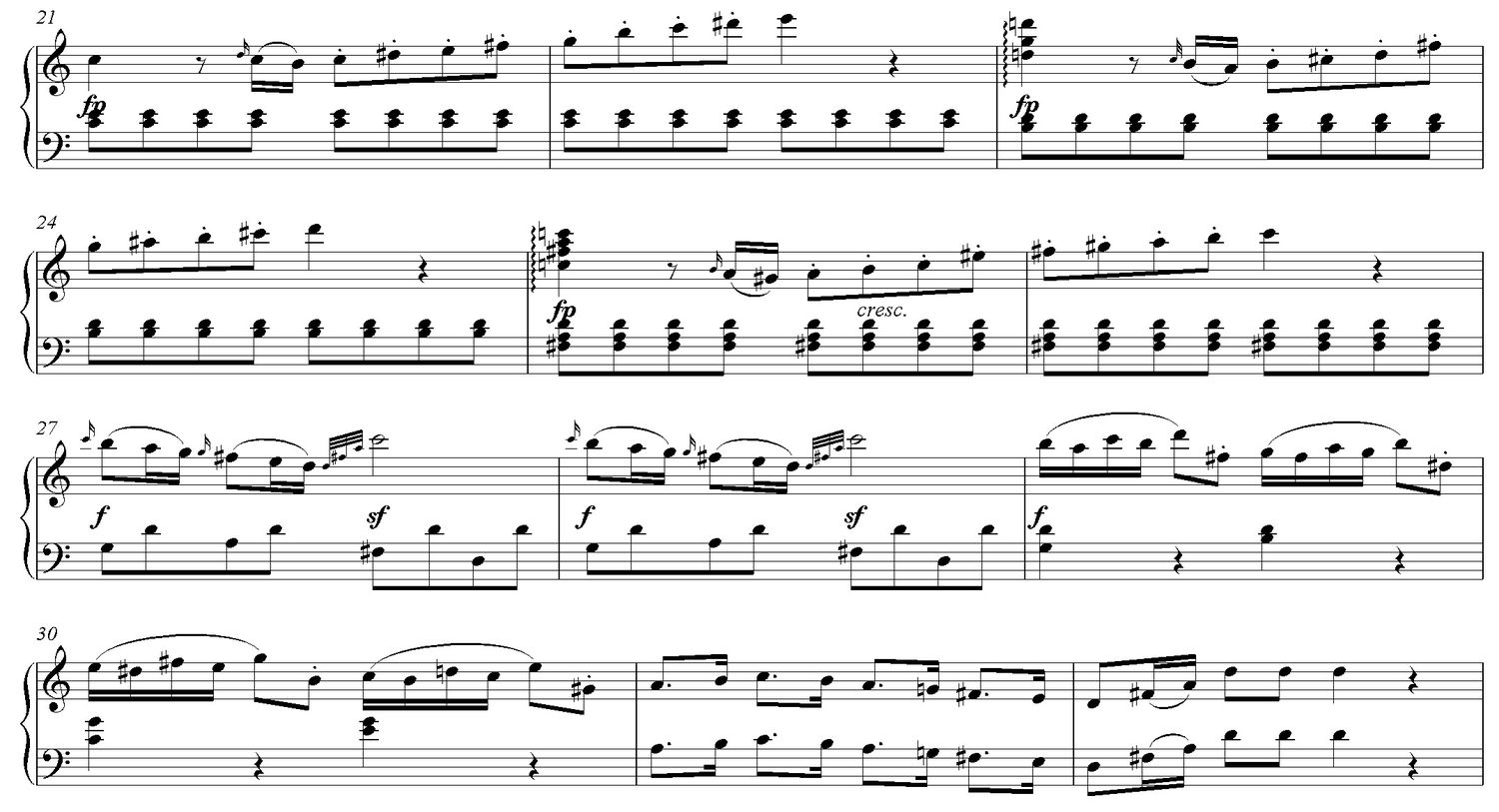Home>Production & Technology>Music Theory>How To Recognize Chords In Music Theory


Music Theory
How To Recognize Chords In Music Theory
Modified: February 9, 2024
Learn how to recognize chords in music theory and enhance your understanding of harmony. Explore chord progressions and deepen your knowledge of music theory.
(Many of the links in this article redirect to a specific reviewed product. Your purchase of these products through affiliate links helps to generate commission for AudioLover.com, at no extra cost. Learn more)
Table of Contents
Introduction
Welcome to the world of music theory! Whether you’re a musician, composer, or just an avid listener, understanding the fundamental concepts of music theory can greatly enhance your appreciation and perception of music. One crucial aspect of music theory is the recognition of chords – the harmonious combination of multiple notes that form the backbone of many songs and compositions.
In this article, we’ll dive into the exciting realm of chord recognition. We’ll explore the terminology you need to know, the different types of chords you’ll encounter, and strategies for recognizing chords both by ear and through analytical techniques.
Now, you may wonder, why is chord recognition important? Well, knowing how to recognize chords allows you to gain a deeper understanding of the structure and emotional impact of a piece of music. It enables you to communicate effectively with other musicians, analyze and transcribe songs, and even create your own compositions.
Whether you’re a beginner just starting to explore music theory or an experienced musician looking to refine your skills, this article will provide you with the knowledge and techniques needed to recognize chords with confidence.
Understanding Basic Music Theory Terminology
Before diving into chord recognition, it’s essential to familiarize yourself with some basic music theory terminology. Understanding these terms will serve as a solid foundation for comprehending the principles behind chords.
Let’s start with the building blocks of music – notes. Notes are the individual sounds that make up melodies and chords. They are represented by alphabetic letters (A, B, C, etc.) and are further categorized into different pitches, such as A, A#, B, and so on. The distance between two notes is called an interval, which plays a crucial role in determining the quality and character of a chord.
Scales are a series of notes played in ascending or descending order, forming the basis of melodies and harmonies. The most common scale is the major scale, which has a specific pattern of whole (W) and half (H) steps. For example, the C major scale comprises the notes C, D, E, F, G, A, and B. Understanding scales is vital in chord recognition since chords are constructed based on the notes within a particular scale.
When multiple notes are played simultaneously, they form a chord. Chords are the building blocks of harmony and add richness and depth to music. They are typically represented by a series of letters and symbols that indicate the type and quality of the chord. For example, C major is denoted as C, C minor is represented as Cm, and so on.
Within a chord, the individual notes are given specific roles. The root is the foundation note upon which the chord is built. The third determines whether the chord is major or minor. The fifth provides stability and adds depth to the chord.
These are just a few of the fundamental music theory terms you’ll encounter when exploring chord recognition. By familiarizing yourself with these concepts, you’ll lay the groundwork for understanding and identifying chords with accuracy and confidence.
The Building Blocks of Chords
Now that we have a good understanding of the basic music theory terminology, let’s dive into the building blocks of chords. A chord is formed by combining three or more notes played simultaneously. The specific combination of these notes determines the quality and character of the chord.
The most basic type of chord is a triad. Triads are made up of three notes: the root, the third, and the fifth. The root serves as the foundation note, while the third and fifth determine the chord’s quality, whether it is major, minor, diminished, or augmented.
For example, let’s take a C major chord. The notes within this chord are C, E, and G. The root note is C, the third is E (which is four half steps above C), and the fifth is G (which is seven half steps above C). The overall combination of these three notes creates the signature sound of the C major chord.
You may be wondering, what determines whether a chord is major or minor? It all comes down to the quality of the third. In a major chord, the third is a major third, meaning it is four half steps above the root. In a minor chord, the third is a minor third, which is three half steps above the root.
For example, a C minor chord consists of the notes C, E♭ (which is three half steps above C), and G. This combination of notes creates a distinct and melancholic sound often heard in various genres of music.
In addition to major and minor chords, there are also diminished and augmented chords. A diminished chord has a minor third and a diminished fifth, while an augmented chord has a major third and an augmented fifth.
Building chords based on triads provides a solid foundation for understanding the more complex chord structures that we’ll explore later in this article. By grasping the concept of triads and the role of the root, third, and fifth within a chord, you’ll be well on your way to recognizing and understanding a wide range of chords.
Major Chords
Major chords are among the most common and widely used chords in music. They have a bright and uplifting sound and are present in various genres, including pop, rock, classical, and jazz.
To construct a major chord, you start with the root note and add a major third and perfect fifth interval above it. The major third interval consists of four half steps, while the perfect fifth interval is seven half steps above the root.
Let’s take the example of a C major chord. The notes within this chord are C, E, and G. The root note is C, the major third interval produces the note E (four half steps above C), and the perfect fifth interval gives us the note G (seven half steps above C). When these notes are played simultaneously, they create the classic sound of a C major chord.
Major chords are often used to convey a sense of happiness, confidence, and stability in music. They are the foundation of many popular songs and provide a solid base for melodies and harmonies to be built upon.
One interesting characteristic of major chords is their ability to evoke different emotions depending on the musical context. For instance, a major chord played softly and slowly might convey a sense of nostalgia or introspection, while the same chord played with intensity and energy can create a feeling of excitement or triumph.
As you continue your journey in music theory, it’s important to familiarize yourself with major chords in different keys, as they each have their own unique sound and flavor. Practicing playing major chords on your instrument or exploring songs that utilize major chords will help solidify your understanding of their sound and structure.
Now that we have explored major chords, let’s move on to another essential chord type in music theory: minor chords.
Minor Chords
Minor chords are an essential component of music theory and are often associated with a melancholic or or introspective sound. They provide a contrasting emotional tone to major chords and are widely used in various music genres, including blues, jazz, and pop.
To construct a minor chord, you start with the root note and add a minor third and perfect fifth interval above it. The minor third interval consists of three half steps, while the perfect fifth interval is seven half steps above the root.
Let’s take the example of a C minor chord. The notes within this chord are C, E♭ (which is three half steps above C), and G. The root note is C, the minor third interval produces the note E♭, and the perfect fifth interval gives us the note G. When played together, these notes create the distinctive and emotive sound of a C minor chord.
Minor chords are often used to convey a sense of sadness, longing, or introspection. They can add depth and emotional complexity to a piece of music. In many songs, minor chords are strategically used to create tension and build anticipation before resolving into a major chord, adding a satisfying musical arc.
It’s important to note that not all minor chords are created equal. There are variations within the minor chord family, including natural minor chords and harmonic minor chords. The natural minor scale forms the basis for natural minor chords, while the harmonic minor scale introduces alterations to create harmonic tension and resolution.
By understanding and practicing minor chords in different keys, you’ll gain a greater appreciation for their unique sound and be able to incorporate them effectively in your musical compositions or interpretations.
Now that we have explored major and minor chords, let’s continue our journey into the world of chords by discussing diminished and augmented chords.
Diminished and Augmented Chords
In addition to major and minor chords, there are two other important chord types to explore: diminished and augmented chords. These chords add interesting and distinct flavors to music and can create tension or a sense of anticipation.
A diminished chord consists of a root note, a minor third interval, and a diminished fifth interval. The diminished fifth, also known as a tritone, is six half steps above the root note. Diminished chords have a dissonant and unresolved sound, often associated with suspense or mystery.
For example, let’s consider a C diminished chord. It consists of the notes C, E♭ (which is three half steps above C), and G♭ (which is six half steps above C). When played together, these notes create the distinctive and tense sound of a C diminished chord. Diminished chords can be found in various musical contexts, adding chromatic movement and an intriguing atmosphere.
An augmented chord, on the other hand, consists of a root note, a major third interval, and an augmented fifth interval. The augmented fifth is eight half steps above the root note. Augmented chords have a bright and unresolved quality, often used to create tension or as a passing chord.
For example, let’s consider a C augmented chord. It includes the notes C, E (which is four half steps above C), and G♯ (which is eight half steps above C). When played together, these notes create the unique and vibrant sound of a C augmented chord. Augmented chords are less common than major and minor chords but are used in specific musical contexts to add a sense of tension and harmonic complexity.
Diminished and augmented chords can be used to enhance the harmonic palette of your music. They introduce unexpected sounds and create interesting harmonic movements. By incorporating these chords into your compositions or recognizing them in existing music, you can elevate the emotional impact and depth of your musical expression.
Now that we have explored diminished and augmented chords, let’s continue our exploration by diving into seventh chords and extensions.
Seventh Chords and Extensions
As we delve deeper into the world of chords, we encounter seventh chords and extensions. These chords build upon the foundation of triads, adding additional notes to create richer and more complex harmonies.
A seventh chord is formed by adding a seventh interval above the root note of a triad. This additional note adds color and depth to the chord, extending its tonal possibilities. There are four types of seventh chords: major seventh, minor seventh, dominant seventh, and diminished seventh.
A major seventh chord consists of a major triad with an added major seventh interval. For example, a C major seventh chord comprises the notes C, E, G, and B (which is a major seventh interval above C). Major seventh chords have a smooth and mellow sound, often associated with jazz and sophisticated musical styles.
A minor seventh chord consists of a minor triad with an added minor seventh interval. For example, a C minor seventh chord includes the notes C, E♭, G, and B♭ (which is a minor seventh interval above C). Minor seventh chords have a warm and soulful quality, commonly used in blues, funk, and jazz music.
A dominant seventh chord is formed by adding a minor seventh interval to a major triad. For example, a C dominant seventh chord consists of the notes C, E, G, and B♭. Dominant seventh chords have a strong and resolved sound, often used in blues and traditional harmony as a way of establishing tension and resolving to the tonic.
A diminished seventh chord consists of a diminished triad with an added diminished seventh interval. For example, a C diminished seventh chord includes the notes C, E♭, G♭, and B♭♭ (which is a diminished seventh interval above C). Diminished seventh chords have a dissonant and unresolved quality, often used in dramatic or haunting musical contexts.
In addition to seventh chords, there are extensions that further expand the harmonic possibilities. Extensions are additional notes added to a chord beyond the seventh. Common extensions include the ninth, eleventh, and thirteenth. These extensions add even more complexity and color to the chord structure.
By incorporating seventh chords and extensions into your compositions or recognizing them in existing music, you can explore new avenues of harmonic expression and create captivating musical arrangements.
Now that we have explored seventh chords and extensions, let’s shift our focus to recognizing chords by ear.
Recognizing Chords by Ear
Recognizing chords by ear is a valuable skill that can greatly enhance your musical abilities. Being able to identify chords without reliance on sheet music or chord charts allows you to play by ear, transcribe songs, and improvise with greater ease and confidence. Here are some strategies to help you recognize chords by ear:
Develop a strong sense of relative pitch: Relative pitch is the ability to identify and recognize the relationship between different musical notes. By training your ear to recognize intervals, you can identify the individual notes within a chord and determine its quality. Practice interval recognition exercises and train your ear to differentiate between major and minor thirds, perfect fifths, and other intervals commonly found in chords.
Listen for chord characteristic tones: Each type of chord has characteristic tones that distinguish it from others. For example, major chords have a bright and stable sound due to the major third interval, while minor chords have a more somber and introspective quality. Pay attention to these characteristic tones and internalize their sound to more easily identify chords by ear.
Contextualize the chord progression: Chords are rarely played in isolation; they are usually part of a chord progression within a song or piece of music. By listening to the chords in their musical context, you can gain clues about their quality and function. Analyze the relationship between chords, listen for patterns, and identify common chord progressions to help you recognize the chords being played.
Transcribe and analyze music: Practice transcribing songs by ear and analyzing the chords within them. Start with simple songs and gradually work your way up to more complex compositions. This practice will sharpen your listening skills and improve your ability to recognize chords by ear.
Use technology as a helpful tool: There are various ear training apps and software available that can assist you in developing your chord recognition abilities. These tools provide practice exercises, chord identification quizzes, and playback features to aid in your training process.
Remember that recognizing chords by ear is a skill that takes time and practice to develop. Start by focusing on simple chord progressions, and gradually challenge yourself with more complex harmonies. With consistent practice, your ability to identify chords by ear will improve, allowing you to play and appreciate music in a whole new way.
Now that we’ve explored recognizing chords by ear, let’s move on to analyzing chord progressions.
Analyzing Chord Progressions
Chord progressions are the sequence of chords that form the backbone of a song or composition. Analyzing chord progressions involves understanding the relationship between different chords and how they contribute to the overall structure and mood of a piece. Here are some key steps to effectively analyze chord progressions:
Identify the key: Start by determining the key of the song. The key gives you a framework for understanding the chords used and their relationship to the tonic or home note. Look for common key signatures and listen for the note or chord that feels like the tonal center.
Recognize common chord patterns: Familiarize yourself with common chord patterns in different musical genres. Certain chord progressions, such as the I-IV-V progression in the major key, or the i-iv-v progression in the natural minor key, are commonly used and provide a sense of familiarity and stability. By recognizing these patterns, you can quickly identify the chords in a progression and understand their harmonic function.
Pay attention to chord functions: Each chord within a progression serves a specific function. The tonic chord (I) provides a sense of resolution and stability, while the subdominant (IV) and dominant (V) chords create tension and lead to the tonic. Understanding the functions of these chords allows you to anticipate chord changes and make informed musical decisions.
Look for borrowed chords or modulations: Chord progressions often involve borrowing chords from related keys or making key modulations. These changes can create interesting harmonic shifts and add complexity to the piece. Listen for unexpected chord changes and analyze how they contribute to the overall progression.
Consider the emotional impact of the progression: Chord progressions have the power to evoke specific emotions and moods. Analyze how the chords in a progression work together to create a particular atmosphere or feeling. Pay attention to the tension and resolution created by different chord changes and how they contribute to the emotional journey of the music.
By analyzing chord progressions, you gain a deeper understanding of the structure and harmonic choices made by composers and songwriters. This knowledge can inform your own musical compositions, improvisation, and interpretation of existing music.
Now that we’ve explored the analysis of chord progressions, let’s wrap up our journey into the world of chord recognition.
Conclusion
Congratulations on completing this comprehensive exploration of chord recognition in music theory! We have covered the essential terminology, the building blocks of chords, and various types of chords, including major, minor, diminished, and augmented. We also discussed seventh chords, extensions, recognizing chords by ear, and analyzing chord progressions.
By understanding chords and their qualities, you have acquired a valuable skill set that will enhance your musical journey. Recognizing chords by ear allows you to play music more intuitively, transcribe songs accurately, and improvise with confidence. Analyzing chord progressions deepens your understanding of the musical structure and emotional impact of a piece.
Remember, mastering chord recognition takes time, practice, and a good ear. Continuously listen to different types of music, analyze chord progressions, and train your ear to recognize intervals and chord qualities. As with any musical skill, consistent practice and application will lead to noticeable improvement.
Whether you’re a musician, composer, or music enthusiast, the ability to recognize chords opens up a world of possibilities. It allows you to communicate effectively with other musicians, analyze and transcribe songs, and create your own unique compositions.
So, embrace the beauty of chords and let them inspire your musical journey. Whether you’re strumming on a guitar, playing keys on a piano, or singing along to your favorite tunes, understanding and recognizing chords will enrich your musical experience and bring you closer to the heart of the music.
Now, go forth and explore the rich and captivating world of chords in music theory. May your ears be attuned to the harmonies, and may your musical expressions resonate with the power of chords. Happy playing!











